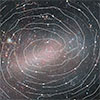| Mar 29, 2022 |
|
|
|
(Nanowerk News) Using data from the VISTA survey of the Magellanic Clouds system (VMC), researchers at the Leibniz Institute for Astrophysics Potsdam (AIP), in collaboration with scientists from the VMC team, confirmed the existence of elongated orbits which are at the backbone of the bar formation process. The method used repeated imaging observations to construct a velocity map of stars in the central region of the Large Magellanic Cloud.
|
|
The Large Magellanic Cloud (LMC) is visible by naked eye from the southern hemisphere as it is the brightest and most massive satellite galaxy of the Milky Way. The LMC is rich in stars that span a large age range, from newly forming stars to stars as old as the universe. It is classified as an irregular galaxy because it is characterized by a single spiral arm and a bar which is offset from the centre of the disc.
|
 |
| Observed orbits of stars within the central parts of the Large Magellanic Cloud. The stars in the central region, along the bar, follow elongated orbits which deviate from a circular shape (dashed contours). (Image: AIP/F. Niederhofer, VISTA VMC Survey)
|
|
“Stellar bar structures are a common feature in spiral galaxies. They are believed to form from small perturbations within the stellar disc that remove stars from their circular motions and force them on elongated orbits,” explains Florian Niederhofer, first author of the now published study. “A specific type of these orbits are the ones that are aligned with the major axis of the bar. These are considered to be the ‘backbone’ of stellar bars and provide the main support of the bar structure.”
|
|
The VISTA telescope was developed to survey the southern sky at near-infrared wavelengths to study sources that emit preferentially in this spectral domain, because of either their nature or the presence of dust. Using data from the VMC survey, the team has now found the first direct evidence for these orbits within the bar of the LMC.
|
|
VMC is a multi-epoch survey of the Magellanic system and a public survey project of the European Southern Observatory (ESO), carried out between 2010 and 2018, aiming to study the stellar content and dynamics of our closest extragalactic neighbours.
|
|
The team developed a sophisticated method to accurately determine proper motions of stars within the Magellanic Clouds.
|
|
In a new study, now published in Monthly Notices of the Royal Astronomical Society (“The VMC survey – XLVI. Stellar proper motions in the centre of the Large Magellanic Cloud”), this method was applied to central parts of the LMC.
|
|
From the measured values, the authors computed the actual stellar motions within the frame of the LMC, producing detailed velocity maps of the galaxy’s internal velocity structure.
|
|
“The stunning level of detail in velocity maps shows how much our method has improved, compared with early measurements some years ago,” says Thomas Schmidt, co-author and doctoral student at AIP. To the researchers’ astonishment, their maps revealed elongated stellar motions that follow the structure and orientation of the bar.
|
|
“Thanks to their close proximity of about 163,000 light-years, we can observe individual stars within the Magellanic Clouds using ground-based telescopes like VISTA,” says Maria-Rosa Cioni, principal investigator of the VMC project and head of the Dwarf Galaxies and the Galactic Halo section at AIP. “Thus, these galaxies provide us with a unique laboratory to study in great detail the processes that shape and form galaxies.”
|
|
Of great interest are the dynamics of the stars, since they bear valuable information about the formation and evolution of the galaxies. However, for a long time, the one-dimensional line-of-sight velocities of stars have been the only source of dynamical information. These velocities can readily be measured by spectroscopic Doppler shifts, which rely on the effect that the observed light of a star appears bluer or redder depending on whether it approaches or moves away from us.
|
|
In order to obtain the full three-dimensional velocities of the stars, it is necessary to know the proper motions of the stars, which are the apparent two-dimensional motions of the stars in the plane of the sky. These motions can be obtained by observing the same stars multiple times over a given time period, typically several years. The displacements of the stars are then determined with respect to nearby reference objects. These objects can be, e.g., very distant background galaxies, which can be assumed to be at rest, given their large distances, or stars with already known proper motions.
|
|
Since the observed motions of stars as seen from Earth are minuscule, precise measurements are still challenging. At the distance of the Magellanic Clouds, the observed motions of the stars are on the order of milli-arcseconds per year – one milli-arcsecond is about the size of an astronaut on the Moon as seen from Earth.
|
|
“Our discovery provides an important contribution to the study of dynamical properties of barred galaxies, since the Magellanic Clouds are at present the only galaxies where such motions can be investigated using stellar proper motions. For more distant galaxies this is still beyond our technical capabilities,” says Florian Niederhofer.
|
|
In total, it took 9 years of monitoring to accumulate enough images to be able to measure these tiny motions. “This unexpected measurement adds to a number of important results obtained by the VMC team,” proudly adds Maria-Rosa Cioni.
|


